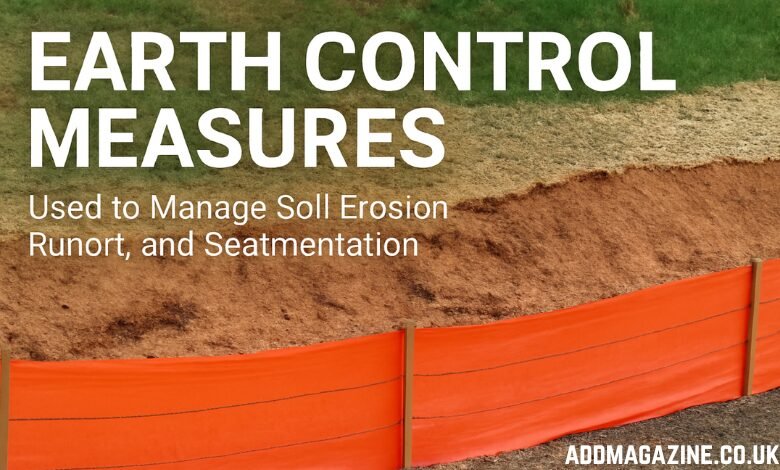Earth Control Measures (ECMs) are essential practices that prevent soil erosion, manage stormwater runoff, and reduce environmental pollution, particularly during construction projects. These measures are not only critical for preserving the environment but also play a significant role in complying with regulatory standards set by local authorities. In this blog, we will explore the concept of ECM, its importance, key techniques, and how they are implemented in construction sites to protect the environment.
What Are Earth Control Measures?
Earth Control Measures are techniques and practices implemented on construction sites to minimize the impact of soil erosion, sedimentation, and runoff. These practices ensure that the earth is protected from degradation caused by human activities such as construction, excavation, and land development.
The primary objective of ECM is to control the discharge of suspended solids (silt, mud, and other particles) into public waterways, which can lead to water pollution. They also aim to prevent the erosion of exposed soil surfaces caused by heavy rain and strong winds. Construction activities, such as land clearing, excavation, and demolition, expose soil to erosion, which can lead to significant environmental damage if left unchecked.
Why Are Earth Control Measures Important?
ECMs are not just about adhering to regulatory requirements; they are integral to sustainable land management practices. Some of the key reasons ECMs are vital include:
- Protection of Waterways: Unchecked soil erosion can lead to sedimentation in rivers, streams, and lakes, resulting in reduced water quality. This can harm aquatic life and interfere with water treatment processes.
- Preventing Soil Degradation: Erosion caused by construction activities can strip away the fertile topsoil, making the land less productive for future use. Soil erosion also contributes to desertification in certain areas.
- Flood Prevention: Proper management of runoff water helps prevent localized flooding, especially in areas with poor drainage systems. This reduces the risk of property damage and improves public safety.
- Complying with Environmental Regulations: Many jurisdictions have strict environmental laws regarding water quality and construction practices. Implementing ECMs helps construction projects meet these requirements and avoid penalties.
Key Components of Earth Control Measures
There are several components that make up an effective ECM plan. These measures should be tailored to each site’s specific conditions, including soil type, climate, and topography. Below are the common components involved in ECM:
- Silt Fencing: Silt fences are temporary barriers made of porous fabric that trap silt and sediment. They are commonly used around construction sites to prevent the migration of loose soil into nearby waterways.
- Erosion Control Blankets: These are protective blankets or mats that cover exposed soil to reduce wind and water erosion. They are particularly effective on steep slopes or areas prone to runoff.
- Sediment Basins: Sediment basins are large ponds designed to collect and hold stormwater runoff, allowing suspended particles to settle before the water is discharged into public drains or natural water bodies.
- Check Dams: These are small dams built along drainage channels to slow down water flow, allowing sediment to settle before water is released. Check dams are especially useful in areas with significant rainfall.
- Vegetation: Planting grass, shrubs, or trees is one of the most natural and effective ways to stabilize the soil. Vegetation roots help bind the soil together, preventing erosion and promoting water absorption.
- Water Treatment Systems: In certain construction sites, especially those involved in demolition or large-scale excavation, water treatment systems may be installed to remove pollutants and ensure that runoff complies with local water quality standards, such as reducing the total suspended solids (TSS) content to below 50 mg/liter before discharge.
Implementing Earth Control Measures on Construction Sites
The implementation of Earth Control Measures begins with a well-designed ECM plan. This plan should be developed by a Qualified Erosion Control Professional (QECP), ensuring that it meets local regulations and site-specific requirements.
Steps in Implementing ECM:
- Planning: Before construction begins, contractors are required to submit an ECM plan to the relevant local authority, such as the Public Utilities Board (PUB). The plan should detail the methods and techniques that will be used to manage runoff and erosion during the construction process.
- Designing ECM: The design of ECM should be based on a thorough assessment of the construction site, including soil type, slope, climate conditions, and drainage patterns. This ensures that the measures will be effective in controlling erosion and sedimentation.
- Approval and Endorsement: The ECM plan must be endorsed by a Qualified Erosion Control Professional (QECP), who verifies that the proposed measures will adequately mitigate environmental risks. Once approved, the ECM plan can be implemented.
- Implementation: Construction sites should set up the approved ECM measures before beginning any land-disturbing activities. This includes installing silt fences, laying down erosion control blankets, and ensuring proper drainage channels are in place.
- Ongoing Monitoring: ECMs should be monitored regularly to ensure they are functioning effectively. This includes checking for signs of erosion, sediment buildup, or any breaches in the control measures. Necessary adjustments or repairs should be made promptly.
- Maintenance and Removal: After the construction project is complete and the site has been stabilized, the ECM systems should be removed in an environmentally responsible manner. This process involves ensuring that any remaining pollutants or sediment are properly disposed of.
Challenges and Limitations of Earth Control Measures
While ECMs are effective in reducing environmental impacts, there are challenges and limitations to consider:
- Cost: Implementing ECMs can be expensive, especially for large-scale projects. The costs involved in purchasing materials, hiring experts, and setting up systems can add up quickly.
- Effectiveness in Extreme Weather: Severe weather events, such as heavy storms or floods, can overwhelm ECM systems, especially if they were not properly designed or maintained. In such cases, additional measures may be needed to prevent damage.
- Maintenance: Earth control measures require regular monitoring and maintenance to ensure their effectiveness. If the measures are not properly maintained, their ability to reduce erosion and sedimentation may be compromised.
- Temporary Solutions: Many ECMs, such as silt fences and erosion blankets, are temporary measures that need to be removed after the project is complete. This can add to the complexity of site management.
Seepage Control Measures in Earth Dams
Seepage is one of the primary concerns in the design and maintenance of earth dams. Inadequate control of seepage can lead to soil erosion, internal erosion of the dam structure, and even failure. To address these risks, several seepage control measures are implemented during construction and throughout the dam’s lifespan.
One of the most common techniques for controlling seepage is the use of drainage systems, such as filter drains and collection systems. These systems are designed to direct seepage away from critical areas, preventing pressure buildup that could undermine the dam’s integrity. Additionally, impermeable barriers like clay liners or concrete cut-off walls can be installed to block the flow of water through the dam body. The application of bentonite clay or grouting techniques is another effective way to seal off seepage paths and prevent water from penetrating the dam.
Seepage monitoring is also a critical aspect of dam safety. Advanced monitoring techniques, such as piezometers, are used to measure water pressure and seepage flow within the dam. Early detection of seepage issues allows for prompt corrective action, reducing the risk of significant structural damage.
Earth Control Measures in Singapore
In Singapore, where land is scarce and infrastructure development is constant, managing earth control measures in projects such as dam construction, land reclamation, and foundation works is crucial. The country’s dense urban environment makes it particularly important to ensure soil stability and prevent erosion during construction. Earth control measures in Singapore are governed by strict regulations and standards, often developed by the Building and Construction Authority (BCA), to ensure that construction sites are managed safely and efficiently.
For instance, erosion control measures are commonly implemented on construction sites to minimize the displacement of soil during heavy rainfall. Techniques like mulching, silt fences, and sediment basins are used to control soil erosion and keep the surrounding environment protected. Singapore also employs stormwater management systems in urban construction projects to control runoff and reduce the risk of flooding.
In more specialized projects, such as dam construction and large-scale earthworks, soil stabilization techniques—such as lime or cement stabilization—are frequently used to improve the load-bearing capacity and reduce the permeability of the soil.
Certificate of Competency (COC) in Earth Control Measures
In many countries, including Singapore, professionals working in the field of earth control measures are required to obtain a Certificate of Competency (COC). This certification serves as evidence that the individual has received the necessary training and possesses the knowledge to implement, monitor, and maintain earth control measures effectively.
The COC in Earth Control Measures ensures that workers and officers understand the complexities of managing soil, preventing erosion, and controlling seepage in earth dams and other large-scale civil works projects. This certification is particularly important for individuals working on high-risk projects, such as dam construction or reclamation works, where the integrity of the land and structure depends on proper earth control techniques.
To obtain a COC in Earth Control Measures, candidates typically undergo a rigorous training program that covers topics such as soil properties, construction techniques, and environmental protection. Practical experience in the field is also a key component of the certification process. This ensures that professionals are well-equipped to manage the unique challenges associated with earth control in different environments.
Earth Control Measure Officer Course
The Earth Control Measure Officer Course is an essential training program for individuals who are looking to specialize in earth control management, especially in the context of large-scale construction projects such as earth dams, tunnels, and land reclamation works. This course provides a comprehensive understanding of soil properties, erosion control, stabilization techniques, and the overall management of earthworks.
Participants of the course are introduced to various earth control measure technologies and systems, including the use of geotextiles, retaining walls, and drainage systems. The course also emphasizes the importance of site monitoring and how to adapt control measures to the unique conditions of each project site.
Upon completion of the course, participants typically receive a certification that qualifies them to oversee earth control measures on construction sites. The course is especially important in regions where environmental factors such as heavy rainfall or soil instability could pose a risk to construction projects.
Earth Control Measure Officer Course in Singapore
In Singapore, the Earth Control Measure Officer Course is a mandatory program for professionals working in the field of construction, particularly in civil engineering and large-scale infrastructure development. The course is conducted by recognized training providers and adheres to local regulations and best practices set by authorities such as the Building and Construction Authority (BCA).
The program covers essential topics such as erosion control, seepage prevention, soil stabilization, and environmental protection. Participants learn how to implement earth control measures in an efficient and sustainable way while ensuring compliance with local guidelines. The course is specifically designed to equip professionals with the skills to manage the challenges posed by Singapore’s urbanized environment, where space constraints and environmental concerns often complicate construction BNactivities.
Upon completion of the Earth Control Measure Officer Course in Singapore, individuals are equipped with the knowledge to monitor and manage earth control activities effectively, ensuring both the safety of construction sites and the protection of the environment.
Conclusion
Earth Control Measures are critical for mitigating the environmental impacts of construction projects. They help prevent soil erosion, reduce water pollution, and ensure that stormwater runoff is properly managed. By implementing effective ECMs, construction sites can comply with regulatory requirements, protect local ecosystems, and contribute to sustainable development.
As the construction industry continues to grow, the importance of ECMs will only increase. Ensuring that these measures are properly planned, implemented, and maintained is essential for minimizing the environmental footprint of construction activities and preserving the health of our natural waterways for future generations.




